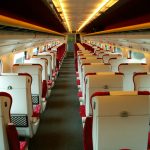W
hen a commercial aircraft takes off, it will usually be traveling at round 130-160 knots an hour. Landing speed is very similar, give or take a few knots.
A Boeing 737-800, for example, will have a typical landing speed of 180-200 knots.
With so much power required to complete these critical maneuvers, a pilot must have the skills and devices available to decelerate and come to a complete stop as quickly and safely as possible. However, decelerating before and throughout landing requires more than just skill and a single braking system alone. There are in fact three decelerating devices that come into play here, and each has a very important part to play in an airplane’s performance.
Wheel Brakes
When an airplane lands or needs to decrease speed when it has already reached high speeds on the runway, the wheel brakes are used. If wheel brakes were used on their own to stop the aircraft, the stress caused to the wheels by the mechanical braking components would be so powerful that they would be ripped apart. However, when used with the other two components we list here they are very effective indeed.
The performance of the wheel brakes largely depends on a number of factors. These include:
- The condition of the tire tread
- Tire inflation pressure
- The condition of the runway surface
- The degree of brake wear and tear
- The majority of modern commercial aircraft are fitted with carbon wheel brakes, but steel brakes may be encountered on older aircraft types.
Mechanical Spoilers
Mechanical spoilers are present on both the upper wing surfaces and within the tail cone. When deployed, these spoilers work to increase aerodynamic drag on a moving airplane. Both upper wing spoilers and the “clamshell” spoilers in the tail can also be used in-flight as air brakes, and their doors can be operated hydraulically and pneumatically.
Mechanical spoilers have three main functions:
- In-flight braking for reduction of speed
- Air braking when on the ground
- In-flight roll control used when turning the aircraft
Aircraft are designed to fly “clean”, that is without any drag. Spoilers get their name because they effectively spoil the clean aerodynamics of the airplane by causing drag and slowing the aircraft.
Thrust Reversers
When the engines are producing forward motion at high speed, the most effective way to decrease speed is to use thrust reversers to reverse the engine exhaust system. The pilot does this by promptly selecting all thrust levers to the ground idle position, and deploys reverse thrust or reverse propeller pitch depending on the aircraft type.
The hot gas stream from the engine exhaust is reversed by the thrust reverser door, a hydraulically operated “bucket” style door that can be set in deployed/stowed position. When in forward thrust mode, these doors create the engine’s propelling nozzle. Thrust reversers are just one of the components of nacelle systems on commercial aircraft, the aerodynamic structure surrounding the jet engine.
Conclusion
While the vast majority of commercial aircraft land safely without a hitch, hard landings and runway overruns still account for over a third of all general aviation accidents. While these incidents are less likely to result in fatalities compared to other airplane crashes – poor landings account for only 3 to 4 percent of fatal accidents – almost 500 planes experience a bent fuselage as a result. A smooth landing is highly dependent on the appropriate usage and the pilot’s knowledge of each of the decelerating devices onboard.



